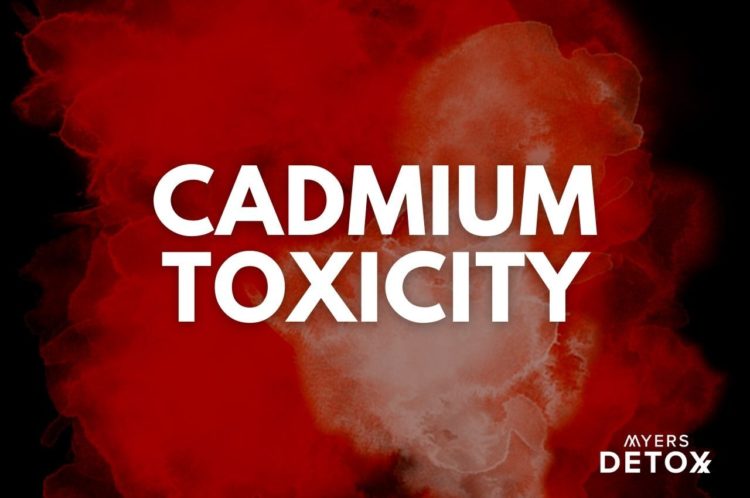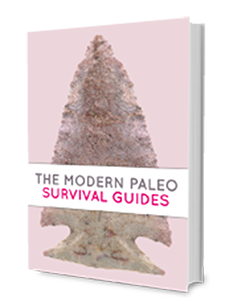Cadmium Toxicity

Cadmium is a heavy metal that is incredibly toxic to the human body and ever-present in our environment. It targets many systems of the body and can cause a multitude of different symptoms. Cadmium toxicity almost always goes undetected by most traditional physicians.
Cadmium toxicity occurs when high levels of the element are accumulated in the body, whether it’s through the ingestion of food or drink, inhalation or direct exposure. Cadmium is involved in all of the major diseases of our time, including cancer, diabetes, arthritic syndromes, heart disease, kidney disease, depression, adrenal burnout, and others. The Environmental Protection Agency has classified Cadmium as a known carcinogen due to the dangerous effects it can have on human health (5).
Sources of Cadmium
Cadmium is an incredibly toxic metal and is ever-present in our environment primarily due to industrial dumping. Cadmium is a metal that also occurs naturally in the environment. It accumulates in the body through food and water, but also through the air we breathe and the environment in which we live.
Cadmium can be found in such things as (1, 6, 8, 9):
- Air pollution (from the incineration of rubber tires, plastic and paints)
- Artist’s paints
- Auto exhaust
- Batteries and corroded batteries in dumps
- Burning coal
- Candy
- Ceramics
- Cigarettes and cigarette smoke (tobacco and marijuana)
- Coffee
- Congenital intoxication
- Contaminated drinking water
- Copper alloys
- Dental alloys
- Dental materials like crowns
- Electroplating
- Fertilizers
- Food grown on cadmium contaminated soil (sewage sludge, chemical fertilizers, and contaminated irrigation water)
- Fungicide
- Galvanized pipes
- Hydrogenated oils
- Incineration of tires, rubbers, and plastics
- Instant coffee
- Iron roofs
- Large ocean fish – tuna, cod, haddock
- Marijuana
- Metal coatings
- Motor oil
- Occupational exposure (through things such as the manufacturing of batteries, semiconductors, dental materials)
- Pigments
- Plastics
- Plated containers
- Processed and refined foods
- Refined grains, flours, cereals
- Rubber
- Rubber carpet backing
- Seafood (cod, haddock, oysters, tuna)
- Sewage
- Shellfish
- Silver polish
- Smelters
- Soft water
- Solder (including in food cans)
- Tap water
- Vapor lamps
- Water (city, softened, well)
- Welding material
Mineral deficiency plays a role in contributing to cadmium toxicity. When one is nutritionally deficient in calcium, iron, protein, and/or zinc, cadmium is absorbed by the body to fill these “nutritional gaps.” (6) Cadmium replaces the deficient nutrients to keep the body running. Over time, as more and more cadmium is accumulated, toxicity symptoms will begin to present.
Toxic elements, like cadmium, replace nutrient minerals in enzyme binding sites. When this occurs, the metals inhibit, over-stimulate, or otherwise alter thousands of enzymes. An affected enzyme may operate at 5% of normal activity. This may contribute to many health conditions. Toxic metals may also simply deposit in many sites, causing local irritation and other toxic effects (7).
Toxic metals may also replace other substances in other tissue structures. The replacement weakens these tissues, such as the arteries, joints, bones, and muscles. Cadmium replaces zinc in vital enzyme binding sites. When there is a deficiency of zinc, the body is forced to use cadmium for repair. This can include the arteries, skin and other areas of the body where zinc is used for repair.
As you can see, the symptoms of cadmium toxicity are in direct correlation to a lack of the healthy minerals they replace (iron, calcium, and zinc). This is why mineral balancing is so important!
Symptoms of Cadmium Toxicity
Cadmium poisoning has a vast variety of symptoms. It can affect a multitude of systems in the human body. Toxicity of this element is known to show its presence in the Nervous, Cardiovascular, Digestive, Endocrine, Respiratory, Excretory, and both the male and female Reproductive Systems. (1) It even affects our energy levels and the chemical makeup of our brain.
Cadmium is a powerful stimulant to the adrenal glands. It irritates and boosts adrenal activity, although it does this in the unhealthy way that stimulants do, not a healthful manner. In fact, many need their cigarettes and coffee, and even marijuana, to give them their daily boost to their adrenal glands. Cadmium is one of many stimulants in these substances.
Dr. Lawrence Wilson believes that Cadmium hardens and toughens the tissues, and ages the body. He says that it is associated with hardening of the arteries, hardening and destruction of the kidneys, and of all the organs, in fact. This hardening can actually feel good, as though one is getting stronger and tougher, which is true, but it does so in a manner that actually weakens the entire body and opens it up to more cancers, and particularly heart disease. (7)
Some of the symptoms associated with cadmium toxicity include (1, 5, 6, 7):
- Abdominal pain
- Aches
- Ages the skin
- Alcoholism
- Alopecia
- Anemia
- Arteriosclerosis
- Arthritis (osteo and rheumatoid)
- Bone disease
- Bone pain in middle of bone(s)
- Cardiovascular disease
- Cavities and tooth deformities
- Cerebral hemorrhage
- Cirrhosis
- Cramps
- Depression
- Diabetes
- Diarrhea
- Digestive disturbances
- Emphysema
- Enlarged heart
- Flu-like symptoms such as chills, muscle weakness, and aches (again, when breathing in cadmium-polluted air)
- Fragile bones
- Growth impairment
- Headaches
- High cholesterol
- High blood pressure
- Hyperkinetic behavior
- Hyperlipidemia
- Hypertension
- Hypoglycemia
- Impaired bone healing
- Impotence
- Inflammation
- Infertility
- Joint pain
- Kidney disease (cadmium is very toxic to the kidneys)
- Learning disorders
- Liver damage
- Lung disease
- Low energy
- Low sperm count
- Lung disease
- Memory loss/brain fog
- Migraines
- Muscle weakness
- Nausea
- Nerve cell damage
- Prostate dysfunction
- Reduced fertility/reproductive disorders
- Shortness of breath
- Smoker’s cough
- Schizophrenia
- Strokes
- Swelling of the nose, pharynx, and larynx (when chronically inhaling cadmium)
- Vomiting
Health Conditions Caused by Cadmium
Cadmium Toxicity affects multiple parts of the body. This is why it can be almost impossible to diagnose cadmium toxicity and is frequently overlooked by traditional medical practitioners. Cadmium affects the following systems in the following ways (1,7):
- Cancer: Cadmium is a very toxic metal and usually associated with the development of cancers.
- Nervous System: Cadmium inhibits release of acetylcholine and activates cholinesterase. This results in a tendency for hyperactivity of the nervous system. Cadmium also directly damages nerve cells.
- Energy: Cadmium causes strong inhibition of essential enzymes in the Krebs energy cycle.
- Bones and Joints: Cadmium alters calcium and phosphorus metabolism, thus contributing to arthritis, osteoporosis and neuromuscular diseases. The findings of one study, conducted by the Division of Laboratory Medicine, Department of Toxicology, at the Medical University of Silesia, showed that cadmium has both a direct and indirect toxic effect on bones (3).
- Cardiovascular System: Cadmium replaces zinc in the arteries, contributing to brittle, inflexible arteries.
- Digestive System: Cadmium interferes with production of digestive enzymes that require zinc.
- Reproductive System: In men, low sperm counts, prostate problems and impotence can result from cadmium-induced zinc deficiency. In women, cadmium can cause reduced fertility.
- Endocrine System: Zinc is required for growth and insulin release. Cadmium can contribute to failure to thrive, delayed growth development, and diabetes.
- Excretory System: Cadmium accumulates in the kidneys, resulting in high blood pressure and kidney disease.
- Dental: Alterations in calcium and vitamin D activity, caused by cadmium toxicity, can result in cavities and tooth deformities.
- Psychological: Cadmium toxicity is associated with learning disorders and hyperactivity. This may be due to zinc deficiency, or to inhibition of acetylcholine release in the brain.
- Reproductive Health: Birth defects often are related to cadmium, when it replaces zinc and other metals in vital genetic functions and in the DNA and RNA of the body. This causes defective genetic expression, which is not the same as defective genes. (7)
Some of the many adverse health conditions caused by cadmium include (1, 2, 5, 6):
- Alopecia (hair loss)
- Adrenal fatigue
- Anemia
- Atherosclerosis
- Arteriosclerosis
- Arthritis, osteo
- Arthritis, rheumatoid
- Aging
- Birth defects
- Bone repair, inhibited
- Cancer, pancreatic and others
- Cardiovascular disease
- Cerebral hemorrhage
- Cirrhosis of the Liver
- Decreased fertility
- Diabetes
- Elevated cholesterol
- Emphysema
- Enlarged heart
- Failure to thrive syndrome
- Hyperlipidemia (high levels of fat in blood)
- Hyperactivity in children
- Hypertension
- Hypoglycemia
- Lung damage
- Inflammation
- Kidney damage
- Migraines
- Osteoporosis
- Prostate function lowered
- Schizophrenia
- Strokes
- Testosterone levels (change in)
- Reduced sex drive
- Vascular disease
How to Support Your Body’s Natural Elimination of Cadmium
An antagonist is an element that can help support your body’s natural detox mechanisms as it pushes cadmium out of the body. The following are antagonists of cadmium (1, 7):
- Calcium
- Zinc
- Copper
- Vitamin D
- Vitamin C
- Iron
- Manganese
- Protein
A note on detox symptoms: When cadmium is being pushed out of the body, a person may feel tired, moody, emotional, and sometimes very uneasy and vulnerable for a few days. When a large cadmium elimination occurs, one may notice odd smells or tastes, a lot of fatigue and perhaps pain in the kidneys, bones or elsewhere. It usually passes quickly, however.
Another symptom of cadmium elimination that is a reddish, itchy, burning rash on the face only. It, too, is temporary and passes.
How to Detect Cadmium in Your Body
If you think you’ve been exposed to pollutants that may be damaging to your health, the best thing you can do is test your heavy metal levels.
To do this, I recommend a Hair Tissue Mineral Analysis (HTMA) test because it’s the least expensive and most convenient way to test for contaminants like cadmium. It doesn’t require any type of blood draw either – just a small sample of your hair. And there’s no need to even leave the house!
HTMA testing measures heavy metal and mineral concentrations in your hair, which is one of the most common places that heavy metals like to hide. It’s a good way to get a highly accurate snapshot of what’s going on in your body without invasive procedures or expensive scans.
Using an HTMA, you can identify exactly which heavy metals have infiltrated and been absorbed by your body so you can take actionable steps to protect your health.
The information revealed in an HTMA is crucial because, once you have pinpointed which pollutants are in your system, you can take actionable steps to:
- Support the body’s natural excretion of these pollutants from your system
- Shield yourself from further exposure to sources of these toxic health hazards
- Detox from everyday living
- Support and maintain a clean and healthy lifestyle
Once you have your HTMA test results, you can look at them with a trained practitioner and come up with a personalized plan to support your body’s natural detoxification.
If you think you’ve been exposed to health hazards like cadmium and it may be hiding in your system, order a Hair Tissue Mineral Analysis. From there, you can plan your next steps to reclaim your vitality.
*Please note that A Hair Mineral Analysis (HTMA) is not intended to diagnose, treat, cure, reverse, or prevent any disease. It is not intended to replace any other medical test(s) that may be prescribed by your medical doctor.








